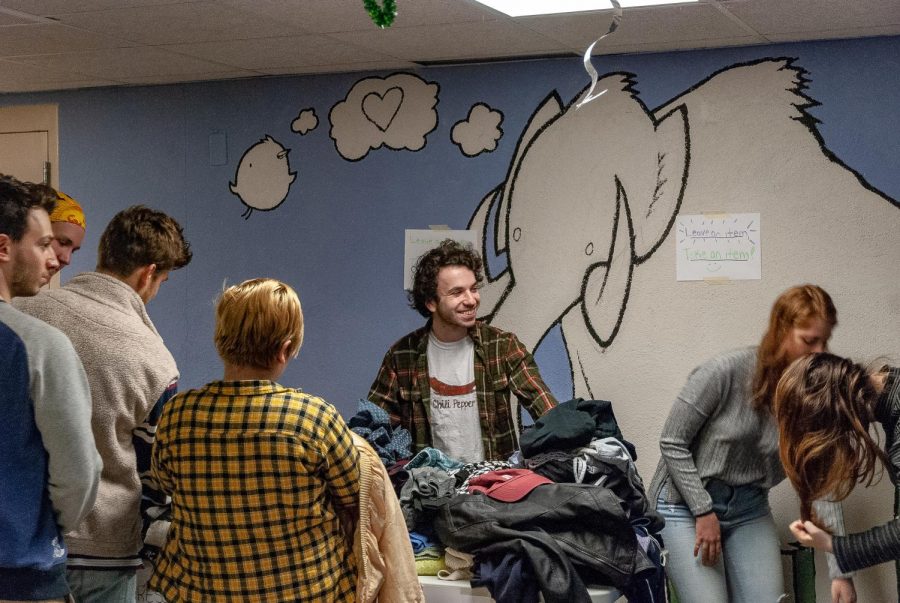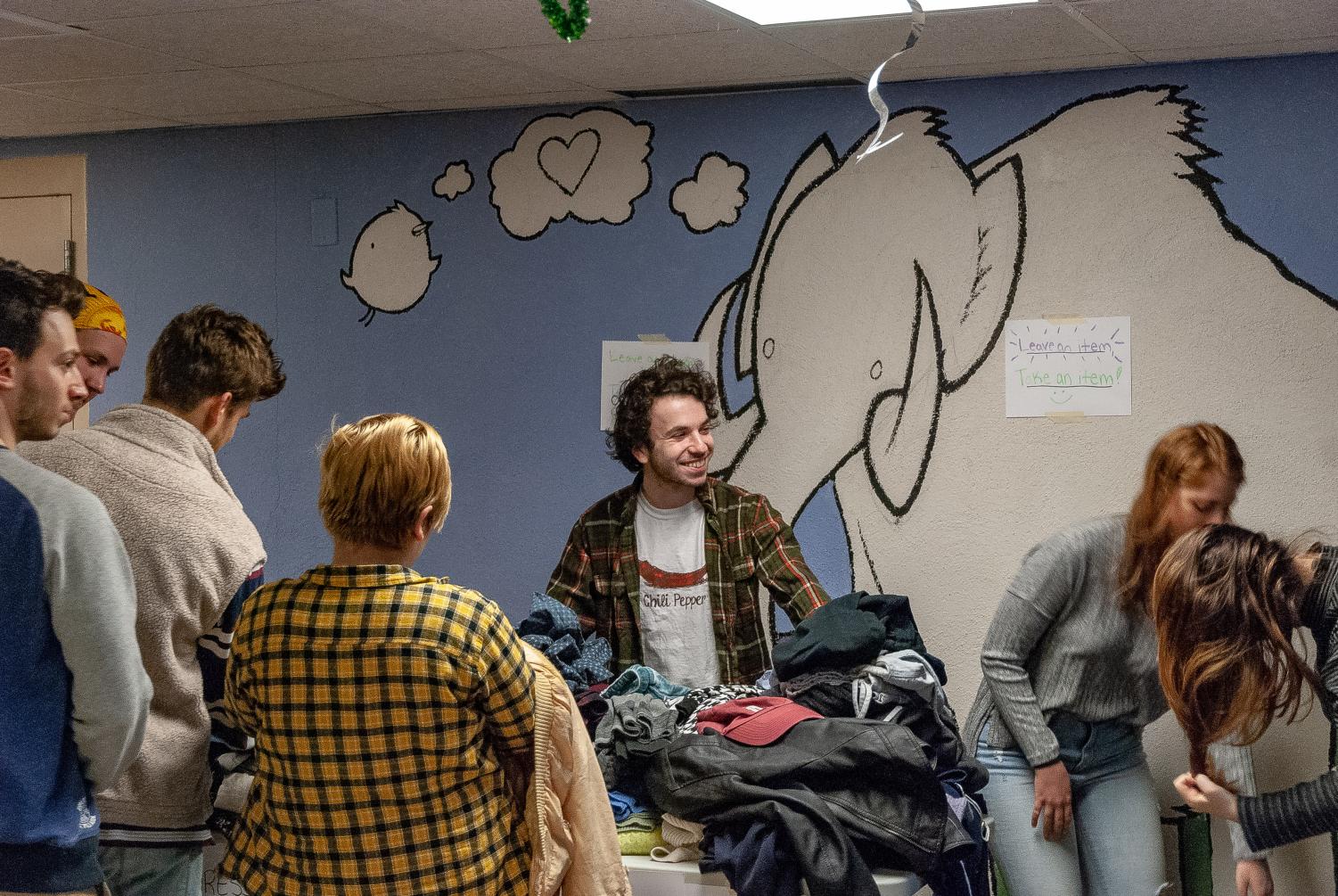fashion |
- The Struggling Fashion House Roberto Cavalli Closes Its U.S. Stores - The New York Times
- Universal Standard Is Revolutionizing How To Shop For Plus-Size Fashion Online - Forbes
- Floral Fashion: symbolism for the past, present and future - Kent Wired
- Exactly How Bad Is Fashion for the Planet? We Still Don't Know For Sure - The Business of Fashion
- UMass students fight fast fashion with clothing swap at Greeno Sub Shop - The Massachusetts Daily Collegian
| The Struggling Fashion House Roberto Cavalli Closes Its U.S. Stores - The New York Times Posted: 01 Apr 2019 12:07 AM PDT  LONDON — The ailing Italian luxury house Roberto Cavalli has shuttered its North American operations, hours after the brand said it was seeking a deal with creditors to stave off a bankruptcy filing and less than a week after the departure of its creative director, Paul Surridge. On Friday, the brand confirmed in an emailed statement that it intended to file a plan with Italian courts that would allow the business to keep running while it secured new investors or ownership. The fashion house, headquartered in Florence and famous for its flesh-baring, flamboyant designs (often in animal prints), has fallen from favor with its fan base in recent years, struggling to turn around falling sales and to maintain its profile in an increasingly competitive global luxury market dominated by the major conglomerates. The Italian private equity company Clessidra has owned a 90 percent stake in Cavalli since 2015. Speculation that it wanted to offload the beleaguered fashion investment grew in recent months, fueled by news of discussions with a number of prospective bidders, including the controversial German fashion designer Philipp Plein and the United States-based investment firm Bluestar Alliance. By Friday, however, no deal had been announced, though a Cavalli spokesman confirmed that discussions were continuing "between shareholders and parties potentially ready to inject cash in Cavalli to provide it with the resources necessary to overcome its current state of financial difficulties." And despite the filing made Friday in Milan by lawyers for Cavalli, employees in its eight stores and four outlets in the United States — in upscale spots like Rodeo Drive in Beverly Hills, Calif. — were told to go home and several high-ranking executives based in the United States resigned. A Cavalli spokesman confirmed Monday that Art Fashion Corporation, the name of the brand's North American subsidiary, would liquidate under Chapter 7 of the United States bankruptcy code by April 4 as part of a restructuring effort. In Florence, Italy, employee unions have a strike planned for Monday, with protests outside Cavalli headquarters. The liquidation of the house's North American operations comes three weeks after questions over the future of Cavalli were raised by unions Filctem Cgil and Femca Cisl. Representatives publicly expressed concern about the future of Cavalli workers and production sites amid rumors of an imminent sale. That a crisis was brewing inside the company was then all but confirmed when Mr. Surridge, the British designer recruited by the Cavalli board to rejuvenate the Florentine fashion house in 2017, confirmed on Instagram that he was leaving. On March 25, he wrote that he had "reached the conclusion that the mission I have signed on has changed and enters a new direction with a new perspective. I now wish to focus on other projects that I put aside in order to achieve our common goals with the Roberto Cavalli Group." Mr. Surridge had been hired as part of a high-stakes turnaround of Cavalli, spearheaded by its chief executive, Gian Giacomo Ferraris. Efforts also included cutting staff by nearly a third and shuttering a string of stores after the departure of the previous creative director, Peter Dundas. However, the design efforts of Mr. Surridge, known as a men's wear designer, had been met with a lukewarm reception from both critics and the brand's fans, and a much-hyped new dawn for Cavalli failed to emerge. |
| Universal Standard Is Revolutionizing How To Shop For Plus-Size Fashion Online - Forbes Posted: 31 Mar 2019 02:26 PM PDT  Universal Standard's Denim by US collection. Universal StandardUniversal Standard has built a business on offering sleek, minimalist pieces to a full range of consumers—and it is now tackling the holy grail of styles, jeans. The New York-based apparel brand has recently launched its Denim by US collection, which comes in sizes from 00 to 40, and starts at $90. Founded by Alexandra Waldman and Polina Veksler, Universal Standard, as its name suggest, aims to appeal to all women, and not just those that many in the industry tirelessly, and perhaps carelessly, cater to. Indeed, when it comes to fashion, size matters. The way garments fit the body, allowing consumers to feel at ease and emboldened is the major reason why fashion is a billion-dollar industry. Yes, design and creativity play a large part, but at the end of the day, fashion is a utilitarian medium. To whit, a dress or pair of jeans needs to be suitable on a range of forms to really have an impact and generate enough sales to be commercially viable. Sadly, most big-name brands stick to a very antiquated mindset, one that proselytizes an ideal body type. It is slender, often devoid of curves and, most important, unattainable for real woman. To be sure, the average American figure ranges from 16 to 18. Yet, many labels don't offer styles in this bracket. And if they do carry larger sizes, the styles are just enlarged variations of what was made for a petite form. "People always think fashion is fashion, that you can compare straight-size fashion to plus-size fashion," said Waldman over the phone. "But you cannot. It's like comparing oranges and giraffes. They have very little in common." Alexandra Waldman and Polina Veksler. Universal StandardThis is what led to Waldman and Veksler to create Universal Standard. In 2014, the duo couldn't find a dress for Waldman to wear to an event. They searched up and down 5th Avenue, looking for an item that worked for her figure. And when they finally did stumble on a selection of larger sizes, what they saw was far less then stellar. "There was a small little corner of the worst polyester you've ever seen—the kind that would set you on fire," recounted Veksler. This was it. That was the first time this world opened up to me. This was the first time I realized there was a problem. This was the first time the light bulb went on in my head that we should do something." With virtually no background in fashion or production (both had careers in finance), Waldman and Veksler went to work on a creating a brand that spoke to all women, to gals who valued great quality and even greater fit. They started with an eight-piece capsule collection of basics: two dresses, two tops, a coat, a jacket and other pieces that they couldn't remember. But what they did recall was that the entire collection sold out. Universal Standard's Denim by US collection. Universal StandardThe reason for this successful drop, as the duo learned, was the power of word of mouth (or in this case, social media). Women with larger builds had dollars to spend, but couldn't find substantial pieces to warrant a purchase. So, when they did find something that flattered, that was made for them in mind, they were ready to share it with world. "There is such desperation on the side of the double-digit-size women to find clothes to dress herself with," said Waldman. "She is very actively combing through the internet, reading everything she can, networking and going through social media to find anything that's out there. When we created jeans, a few people bought them and loved them. Then they started talking about it on their Instagram, Facebook and Twitter. It kind of blew up from there." Universal Standard's denim was so popular that it eventually amassed a waitlist of 1,700. And seeing how the market was ripe for the taking, Waldman and Veksler decided to launch Denim by US. That said, they also realized that offering more sizes wasn't enough. "There are a lot of peccadillos to a consumer who is on the larger side and prefers to shop on the internet," Waldman observed. "And we thought about what it would take for people to have a better understanding." Universal Standard's Denim by US collection. Universal StandardTo that end, Universal Standard's online platform showcases its jeans on models in its full size range. From 00 to 40, every denim style is shot separately at differing angles, allowing shoppers to fully realize their purchases. There is no second-guessing—or, as Waldman put it, "eye-zhoozhing"—if, say, a size 10 would look good on a size-28 frame. "We decided to build See It in Your Size, which is a much more digestible shopping experience if you are direct to consumer," she said. "And I think that a lot of brands are starting to notice how it is very helpful, and are starting to adopt it." By May, they plan on expanding See It in Your Size into all categories. With this display, consumers no longer have to wonder if a garment will fit them. They can be content with what they buy and wear it unabashedly. And that, for all intents and purposes, should be a universal standard. For More, See: Lacoste Teams With Keith Haring On A Capsule Collection Channel Cary Grant's Star Quality With This Sunglass Collection By Oliver Peoples Commit to Your 2019 New Year's Resolutions With These Chic Shopping Finds Follow Barry Samaha on Twitter (@barry_samaha) and Instagram (@barrysamaha). |
| Floral Fashion: symbolism for the past, present and future - Kent Wired Posted: 31 Mar 2019 02:36 PM PDT [unable to retrieve full-text content]Floral Fashion: symbolism for the past, present and future Kent Wired No matter what clothing store you walk into, from Old Navy to Urban Outfitters, there is one print you will always find: floral. These patterns and the inspiration ... |
| Posted: 31 Mar 2019 09:00 PM PDT  LONDON, United Kingdom — Maxine Bédat has spent the last two years trawling for hard facts on the fashion industry's social and environmental impact. It's been a struggle. Bédat plans to launch the New Standard Institute, a database and innovation hub intended to help the industry adopt better practices, in April. She's travelled the globe and spent countless hours on the phone with experts and industry insiders in an attempt to track down the source of commonly cited industry figures. Some — like the idea that the apparel industry employs one in six people worldwide, or that 80 percent of garment workers are women — seemed to be simply made up. When it came to the industry's environmental impact, there were more hard data points, but they weren't necessarily better. "If it weren't such important data it would be funny," she said. "We're finding less of this fake data loop on the environmental side, but there's also just more data gaps." Fashion certainly ranks among the world's dirtiest sectors (even if the "fact" that it's the second-most polluting has been repeatedly debunked). Clothes are made from materials produced by heavily polluting industries like oil and agriculture. Manufacturing processes often involve harsh chemicals and large volumes of water. Merchandise travels further across global supply chains. Unsold and used clothes add to growing piles of waste. But the fact that the industry's inner workings remain more-or-less a black box is a stumbling block for efforts to fix these problems. The opacity surrounding environmental impact can be a convenient excuse to avoid tackling the subject in a meaningful way. And though more brands are signing onto global initiatives to reduce their footprint, many lack the information they need to pursue change effectively. "Ignorance is bliss," said Sanjeev Bahl, founder of denim manufacturer Saitex International, which makes jeans with a lower environmental footprint for brands like Everlane, Eileen Fisher and Ralph Lauren Corp. "You can greenwash the heck out of it and nobody will hold you accountable." Even as scores of brands lay out targets to improve their environmental footprint, they're often relying on bad or incomplete information to figure out where and how to focus their efforts.
As more brands look to improve their sustainability record, groups are developing more tools and databases to help companies approach the issue, from the Council of Fashion Designers of America Inc's guide on sustainability to Bédat's NSI. Brands and activists say that ambitious targets are a useful first step in driving better data collection and accountability, and the industry already has a good enough understanding of the issues to start making significant changes. But these goals become meaningless if they aren't eventually backed up by hard data to make it possible to measure progress. Last year, a group of major fashion brands came together under the auspices of the United Nations to lay out an industry charter for climate action. Companies including Kering SA, Burberry Group PLC, Hennes & Maurtiz AB and Inditex SA have signed on, committing, among other things, to reduce the industry's emissions by 30 percent by 2030. One of their first tasks will be figuring out what it is they're reducing from. "The need for credible data is certainly crucial and something we are trying to address," said the UN's engagement lead on climate change with the fashion industry, Lindita Xhaferi-Salihu, noting the group is working to gather the necessary information. Even the best analysis currently available on the industry's climate impact, a 2018 estimate that it makes up about 8 percent of global carbon emissions, is open to question. ClimateWorks, the group that funded the analysis, took its name off the report, saying more work was needed to "accurately account " for emissions, though it remained supportive of the research. Quantis, the consultancy which conducted the research, said the issue amounted to a difference in methodology and stands by its work. Without this kind of information, the fashion industry is flying blind when it comes to operating more responsibly. "It raises serious questions for companies setting targets," said Linda Greer, a textile expert who spearheaded environmental non-profit The Natural Resources Defence Council's work with the fashion industry until late last year. "The data they need to measure what they're doing and what they need to do in a meaningful way barely exists." Kering has analysed its environmental impact for years, from emissions to water consumption and pollution, but it too has blind spots. The company is targeting a fully transparent and responsible supply chain by 2025. Last year, it said it was 95 percent of the way there. "If you don't have a clear analysis and point of view about which points of impact you have and where your points of impact are, you can't put in place programmes to improve," said Marie-Claire Daveu, chief sustainability officer at Kering.
The challenges facing Kering — one of the biggest fashion companies on the planet — point to how far the industry has to go to gain an accurate read on its environmental impact. Measuring a company or product's environmental footprint requires untangling complicated systems that have grown up over decades with little scrutiny or oversight. And despite years of discussion about the need for greater transparency and understanding of supply chains, many brands simply aren't doing the work. According to the Global Fashion Agenda, around half the industry haven't taken any action on sustainability at all. Companies are quick to embrace trendy initiatives like a ban on fur or intangible long-term targets that can generate positive headlines and drive sales. Data analysis doesn't create the same buzz. "Unfortunately, instead of presenting information, people want to present something that's either a massive number or a sexy story," said Phil Patterson, managing director at Colour Connections Textile Consultancy. "There need to be metrics and some sort of analysis from start to finish of a product." The Sustainable Apparel Coalition, an alliance of more than 200 brands, retailers, manufacturers and industry watchers, has been working since 2011 to build a unified set of tools that can measure the environmental and social impact of products, factories and companies. But uptake has been sluggish and relies on self reporting, leaving gaps. "There's serious holes in the databases available every step of the way," said Greer, who used to serve on the SAC's board. "We've had the same conversation for seven or eight years, and yet the data is not increasing in quantity or quality." Just 7,000 factories completed an assessment in 2017, and fewer than 6,000 have registered for the 2018 assessment cycle. The SAC had originally set a goal to have 20,000 factories on their platform by last year. The SAC said its work marks the first time the industry has embarked on this kind of initiative and will take time. It said it gained 48 new members last year, which it takes as a sign of the industry's growing commitment to change. "We are getting much, much closer to the metrics that are needed to drive change," said Amina Razvi, the SAC's interim executive director.
The lack of data is adding to the complexity companies face when trying to operate in a more climate-friendly manner, such as weighing the benefits and costs of using different types of materials. For instance, cotton's environmental impact can vary greatly depending on where or how it's grown, but that nuance isn't necessarily reflected in tools used to assess the crop's impact. By contrast, recycled polyester is more water-efficient than cotton, but comes with risks around microfibre pollution. "There aren't really any tools out there to allow brands to understand their impact," said Claire Bergkamp, sustainability and innovation director at Stella McCartney. The brand has been at the forefront of efforts to make the industry greener and is looking at ways to commission new research and share its own learnings. Of course, the current knowledge gaps shouldn't stop the industry from moving forward with efforts to improve its environmental performance. "There's a dilemma around how much you want to be evidence-based and how much you want the industry to get moving," said Morten Lehmann, chief sustainability officer at the Global Fashion Agenda. "The house is on fire so we have to move fast, but we can't just do whatever." Related Articles: UK Takes Aim at Fashion's Sustainability Problem Building a Sustainable Brand: How to Get Started Making the Business Case for Sustainability |
| Posted: 31 Mar 2019 09:10 PM PDT Event hosted by Sustainable Style UMass
Shirts, sweaters, shoes, skirts and more were all up for grabs this past Thursday evening in Greeno Sub Shop at the University of Massachusetts. Over 50 students gathered for a clothing swap meant to reuse old and unused clothing and tackle the problem of "fast fashion." The event was organized by Sustainable Style UMass, an initiative created in March by students from UMass Hillel as part of their social justice internship. This was the group's first exchange. "The idea behind this is to eliminate clothing waste," said Gilat Bailen, a freshman sociology major and event organizer who started Sustainable Style UMass after recently learning about "fast fashion," defined by Merriam-Webster as "an approach to the design, creation, and marketing of clothing fashions that emphasizes making fashion trends quickly and cheaply available to consumers." "I think [fast fashion is] one of those things that everyone sort of knows about in the back of their mind, but you don't really want to open your eyes to it," said Bailen. "Once I started really opening my eyes to it, seeing how horrible of an issue this really is and how easily it could be fixed I just thought this [swap] would be a really fun idea." The clothing swap has multiple benefits, according to its organizers. The general rule for the swap was "leave one, take one," where students would trade however many articles of clothing they brought with them in exchange for new ones all for free, while at the same time clearing out their closets of unused or unwanted clothing. Those without clothes to trade could use the digital payment app Venmo to pay the organizers for any clothing they wished to take with them. Sophomore organizer and political science and legal studies major Sofia Langman explained that all proceeds and leftover clothing would also be donated to the Amherst Survival Center, so that these items don't continue to go unused. The organizers added that the group Rack City Thrift aided in donations as well. Rack City's mission statement is that they are a "student-run initiative that strives to keep clothing affordable, ethical, out of the landfill, while supporting on-campus sustainability projects." "The fashion industry is really horrible at this point," Bailen said. "We're basically in an era where clothing brands try to create clothes really fast, really cheap, so that people will throw them away and buy new clothes very fast." Bailen explained that in this fast-paced and trend-based consumer culture that, "so many clothes end up in landfills, it's a huge waste of water and resources [and] the workers – since it's usually outsourced to other countries – are barely paid a dollar an hour." According to the EPA, "landfills received 10.5 million tons of [municipal solid waste] textiles in 2015. This was 7.6 percent of all MSW landfilled." The EPA added, "The recycling rate for all textiles was 15.3 percent in 2015, with 2.5 million tons recycled," meaning only a fraction of discarded clothing generated was recycled. "In doing this [swap] we're trying to promote trading clothes, thrifting, buying more sustainable longer-lasting clothes," said Bailen, "I think everyone has stuff in their closet that they don't want and they're never going to use and you can get new stuff literally for free. And then also it prevents that waste." When asked which brands hold up better than others in terms of sustainability, Bailen noted that moderately more expensive clothing brands with more durable clothing, such as Gap Inc., tend to fare better in fighting fast fashion than Instagram-based brands and lower-cost options, such as Forever 21 and H&M, which she explained are "names that are thrown around a lot." While tackling a serious issue, the organizers also got in on the fun. Bailen and Langman each brought bundles of clothes from home or donated by friends and relatives to the swap. "Everyone brought such cool things, everyone has such nice style. I was nervous it was going to be all like old, used gym T-shirts and things like that, but everyone brought such nice stuff," said Langman, who snagged a reversible jacket for herself as well. "I think this is a really fun thing that anyone can do, like it didn't take a long time to put this together, it didn't take a lot of work, word spread really quickly and like everyone's having a lot of fun, so I don't know why you wouldn't do it," Bailen said. Chris McLaughlin can be reached at at [email protected] and followed on Twitter at @ChrisMcLJournal. |
| You are subscribed to email updates from "fashion" - Google News. To stop receiving these emails, you may unsubscribe now. | Email delivery powered by Google |
| Google, 1600 Amphitheatre Parkway, Mountain View, CA 94043, United States | |






0 Yorumlar